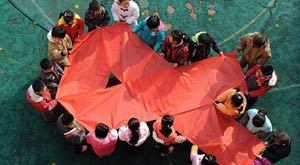Gay sex continues to challenge China's AIDS control
china.org.cn / chinagate.cn by Zhang Rui, August 21, 2014 Adjust font size:
"In my opinion, the most difficult problem in China's AIDS prevention is that only 50 percent of infected people knew about their condition," Han said, "Even if all the patients who knew about their condition started to receive treatment, the other half who are unaware of their HIV-positive status don't have any treatment."
UNAIDS proposed a vision of terminating the AIDS epidemic by 2030. The board stressed that ending the AIDS epidemic would be provisionally defined as the reduction of new HIV infections, stigmas and discrimination experienced by people living with HIV and key populations, and reducing AIDS-related deaths by 90 percent compared to 2010 levels.
This year also marks as 10th anniversary for China's AIDS program with policies such as free HIV tests for all; free treatment for rural and poor urban citizens; free medicine and treatment for HIV-infected mothers to prevent them from infecting their children; and free schooling for children and orphans who have suffered losses related to AIDS. At the same time, China's government departments at all levels will include AIDS patients on the list of people who can receive government aid, Wu Zunyou said.
The central government has increased the special financial fund for AIDS control and prevention by 3.8 times compared to more than a decade ago. The fund reached 2.95 billion yuan (US$480 million) in 2013, while a total of 4.69 billion yuan (US$763 million) from China's governments and other social organizations is also being used to battle the disease.
Enlarging the range of test, the organizations discovered more infected patients, "But the new discovery doesn't mean the infection rate is rising," Wu explained, "It just means many people were not tested." According to the statistics, the worst afflicted regions are Sichuan and Yunnan provinces and the Guangxi Zhuang Autonomous Region.
China is one of the countries in the world leading the AIDS battle, using the most advanced technologies and medical treatment. About 87 percent of Chinese patients received anti-retroviral therapy, compared to 25 percent in 2005, with the help of traditional Chinese herbal medicine, Wu noted. The mortality rate for the disease dropped to 6.6 percent last year from 17.9 percent in 2005, while 95 percent of confirmed HIV/AIDS patients are receiving follow-up care.
China also helps intravenous drug users to battle against AIDS, a key population at risk and the country has set up a system to real-time monitor data from medical institutions and stations in 3,100 counties around the country. China has gone from having just eight methadone clinics a decade ago to 763 today, treating 201,700 people. China has also established 309 demonstration areas for AIDS control and prevention, covering a population of 170 million, and will increase the number this year, Wu added.
China has showed its care for AIDS patients by reducing social discrimination and promoting accurate knowledge in society. What's more, the country also abolished the rules restricting foreigners with AIDS from entering onto Chinese soil in 2010. Wu said they are still investigating how to monitor and help foreign AIDS patients in China and those with a foreign spouse who has AIDS. More policies and rules are on the way, he said.


